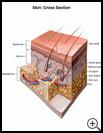
Wound Care for Cuts
________________________________________________________________________
KEY POINTS
- A cut type of wound is an opening on the surface of the skin and may be straight, jagged, or run in several directions.
- The treatment of a wound depends on what caused the wound, where it is, and the size and shape. You can take care of some cuts yourself. A healthcare provider should treat large, deep, jagged, or dirty wounds.
- Wash your hands thoroughly with soap and water before you touch the wound. If it is bleeding and is spurting blood, put pressure on it with a bandage or clean cloth and get the medical care right away.
_______________________________________________________________
What is a cut?
Cuts are wounds that go through one or more layers of skin and may go deeper into the fat, muscle, blood vessels, or other tissues under the skin, even to bone. A cut can be seen on the surface of the skin and may be straight, jagged, or run in several directions. A cut is also called a laceration.
What is the cause?
Most cuts happen:
- During a fall or an accident
- By running into or getting hit with something sharp, pointed, or hard
- While working with something sharp, pointed, rough, or jagged
- By a deep scratch or bite from an animal
What are the symptoms?
Symptoms may include:
- An opening in the skin, or loss of skin
- Pain
- Redness
- Sometimes bleeding
How is it treated?
The treatment of a wound depends on what caused the wound, where it is, and the size and shape. You can take care of some cuts yourself. A healthcare provider should treat large, deep, jagged, or dirty wounds. A wound heals more quickly, and with less risk of infection and scarring, when the wound is kept clean and the edges are held close together as it heals.
Call or see your healthcare provider when you have a new cut if:
- You have a large, deep, or jagged wound
- You have bleeding that will not stop
- Your cut was caused by something that went through several layers of clothing or through a shoe
- Your cut happened in a dirty setting such as a barnyard, construction site, or animal shelter
- You have numbness or tingling near the wound
- You have not had a tetanus shot in the last 5 years and have a wound caused by a dirty object or there is dirt in the wound
- There are foreign objects in the wound, such as wood, glass, or metal slivers
- You can see bone, muscle, or tendon in the wound
- You have any questions about how to treat the wound
How can I take care of myself?
If you have a small cut:
- Wash your hands thoroughly with soap and water for at least 20 seconds before you touch the area.
- Clean the wound as well as possible with mild soap and water. Remove any bits of dirt, small pieces of rock, or other debris that you can easily see, but do not poke or pick at the wound.
- If it’s bleeding and is spurting blood, put pressure on it with a bandage or clean cloth and get the medical care right away. You may need to call 911.
- If it’s not spurting blood but oozing, put pressure on the wound with a clean cloth or bandage until the bleeding stops, which may take up to 20 minutes. If the wound is still bleeding after 20 minutes, call your health care provider.
- Keep the wound and the area around it clean and dry. You may need to put a bandage over the area to keep it clean and dry. Change the bandage every day. Change the bandage more often if it gets dirty or wet.
- To prevent infection in a minor wound, you may use a nonprescription antibiotic ointment. Read the labels and buy products that have only the ingredients that you need and are not allergic to. If you are not sure which medicine is best for your wound, ask your pharmacist.
- Don't take aspirin if your wound is bleeding. If needed, take nonprescription pain medicine, such as acetaminophen. Acetaminophen may cause liver damage or other problems. Read the label carefully and take as directed. Unless recommended by your provider, don't take more than 3000 milligrams (mg) in 24 hours or take it for longer than 10 days. To make sure you don’t take too much, check other medicines you take to see if they also contain acetaminophen. Ask your provider if you need to avoid drinking alcohol while taking this medicine. Nonsteroidal anti-inflammatory medicines (NSAIDs), such as ibuprofen or naproxen may cause stomach bleeding and other problems. These risks increase with age. Unless recommended by your healthcare provider, don't take an NSAID for more than 10 days.
- As the wound heals, some swelling, redness, and mild pain are normal.
- Call your healthcare provider if you have:
- Symptoms of infection, which include new or worsening redness, swelling, pain, warmth, or drainage in the area of the wound
- New bleeding from the wound that won't stop
- Pain that is increasing or not getting better with pain medicine
- Red streaks going from the wound toward the center of your body, for example, up your arm
- Fever, chills, nausea, vomiting, or muscle aches
- Any questions about caring for the wound

